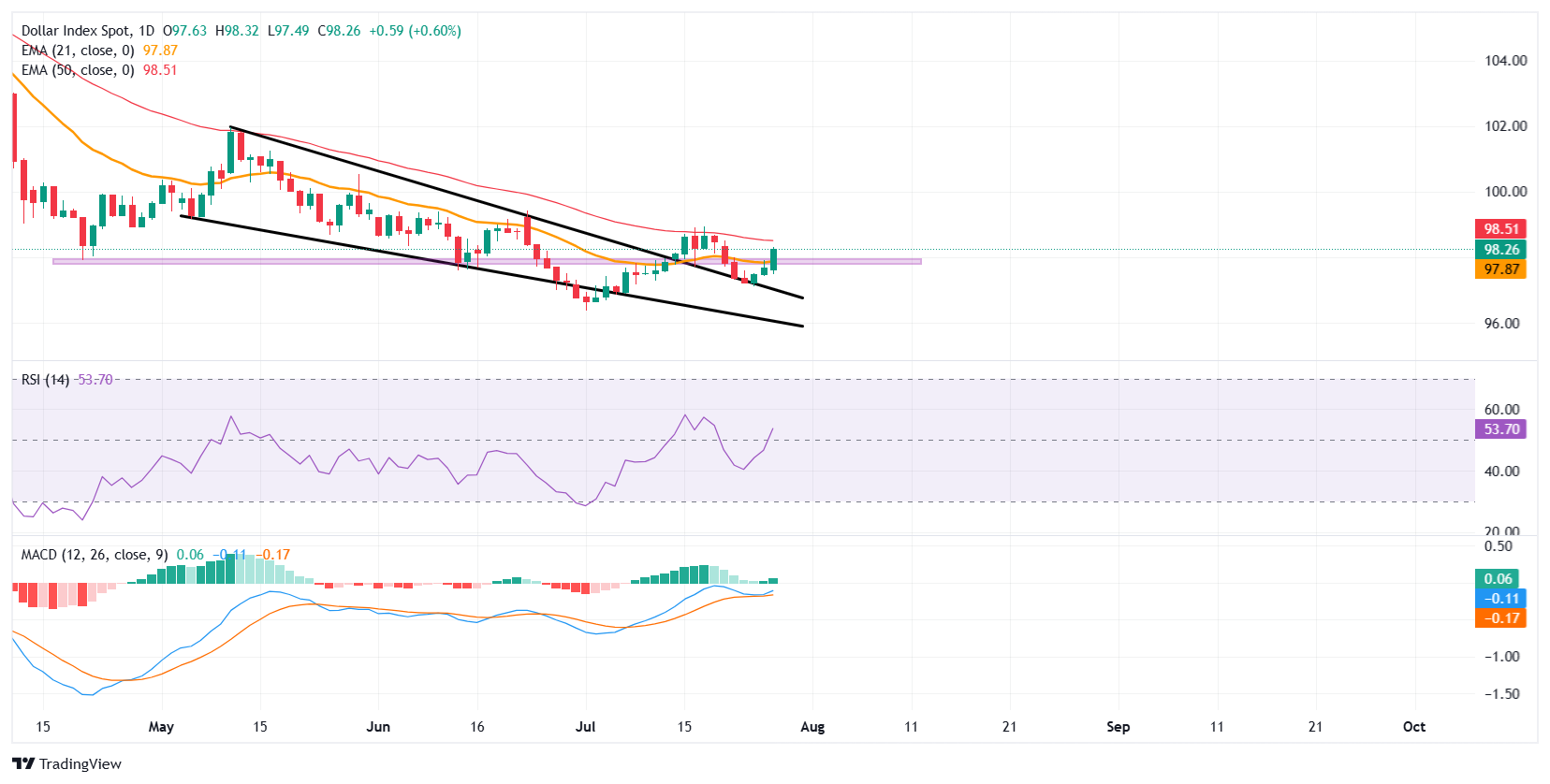Created
: 2025.07.28













![]() 2025.07.28 21:39
2025.07.28 21:39
The US Dollar (USD) starts the week on a firmer note, extending its modest recovery since Thursday, as easing global trade tensions lift investor sentiment. Interestingly, the Greenback, which typically underperforms in a risk-on environment, is finding support despite improving risk appetite, underpinned by expectations that the Federal Reserve (Fed) will leave interest rates unchanged at its monetary policy decision on Wednesday. Notably, a flurry of trade agreements finalized last week is also acting as a tailwind for the Greenback, with the August 1 tariff deadline looming and keeping markets on edge.
The US Dollar Index (DXY), which tracks the value of the Greenback against a basket of six major currencies, extends gains for the third consecutive day, climbing nearly 0.50% during American trading hours as markets cheer the breakthrough trade agreement between the United States (US) and the European Union (EU). At the time of writing, the index is hovering around 98.15, marking its highest level in nearly a week.
The new US-EU framework trade agreement was finalized after US President Donald Trump and European Commission President Ursula von der Leyen met briefly at Trump's Turnberry golf course in Scotland on Sunday. Under the agreement, the US will impose a 15% tariff levy on most EU imports such as cars, semiconductors, and pharmaceuticals, significantly lower than the previously threatened 30%. According to Reuters, that baseline rate is to be supplemented by "zero-for-zero" tariff exemptions covering strategic sectors including aircraft and parts, select chemicals, semiconductor manufacturing equipment, generic drugs, agricultural goods, and key raw materials.
In return, the EU has committed to purchasing $250 billion in US liquefied natural gas (LNG) annually, totaling roughly $750 billion over three years. The deal also outlines a $600 billion EU investment package in the US, focusing on strategic sectors such as clean energy, defense equipment, and manufacturing. While the agreement leaves existing steel and aluminum tariffs at 50%, officials hinted that a quota-based system could replace them in future negotiations.

The US Dollar Index (DXY) has successfully retested the upper boundary of a falling wedge pattern, a bullish structure it broke out of earlier this month. After reaching a four-week high near the psychological 99.00 mark, the index failed to sustain momentum and reversed sharply lower, slipping to a two-week low near 97.00. However, buyers stepped back in near the wedge resistance-turned-support and defended the level, signaling that the breakout remains technically valid for now.
At the time of writing, DXY is hovering around 98.15, trading above the 21-day Exponential Moving Average (EMA) at 97.87, which coincides with a prior resistance-turned-support zone at 97.80-98.00. However, the 50-day EMA at 98.51 remains immediate resistance and must be cleared for the bulls to regain control. A successful break above this dynamic level could open the door for a retest of the 99.00 psychological zone. On the downside, failure to hold above 97.80 may trigger another retreat toward 97.50 and possibly 97.00.
The Relative Strength Index (RSI) on the daily chart has risen to 53, indicating renewed bullish momentum. The MACD remains in a bullish setup, with the blue MACD line holding above the orange signal line, although both remain below the zero mark, suggesting that the current rebound is still in the early stages of confirmation. The histogram has flipped into positive territory, reflecting improving upside momentum after last week's pullback.
The table below shows the percentage change of US Dollar (USD) against listed major currencies today. US Dollar was the strongest against the Euro.
| USD | EUR | GBP | JPY | CAD | AUD | NZD | CHF | |
|---|---|---|---|---|---|---|---|---|
| USD | 0.81% | -0.02% | 0.24% | 0.05% | 0.69% | 0.52% | 0.39% | |
| EUR | -0.81% | -0.85% | -0.55% | -0.76% | -0.12% | -0.29% | -0.42% | |
| GBP | 0.02% | 0.85% | 0.14% | 0.09% | 0.74% | 0.57% | 0.43% | |
| JPY | -0.24% | 0.55% | -0.14% | -0.17% | 0.42% | 0.28% | 0.31% | |
| CAD | -0.05% | 0.76% | -0.09% | 0.17% | 0.61% | 0.47% | 0.34% | |
| AUD | -0.69% | 0.12% | -0.74% | -0.42% | -0.61% | -0.17% | -0.30% | |
| NZD | -0.52% | 0.29% | -0.57% | -0.28% | -0.47% | 0.17% | -0.14% | |
| CHF | -0.39% | 0.42% | -0.43% | -0.31% | -0.34% | 0.30% | 0.14% |
The heat map shows percentage changes of major currencies against each other. The base currency is picked from the left column, while the quote currency is picked from the top row. For example, if you pick the US Dollar from the left column and move along the horizontal line to the Japanese Yen, the percentage change displayed in the box will represent USD (base)/JPY (quote).
![]()
Created
: 2025.07.28
![]()
Last updated
: 2025.07.28

FXStreet is a forex information website, delivering market analysis and news articles 24/7.
It features a number of articles contributed by well-known analysts, in addition to the ones by its editorial team.
Founded in 2000 by Francesc Riverola, a Spanish economist, it has grown to become a world-renowned information website.
We hope you find this article useful. Any comments or suggestions will be greatly appreciated.
We are also looking for writers with extensive experience in forex and crypto to join us.
please contact us at [email protected].
Disclaimer:
All information and content provided on this website is provided for informational purposes only and is not intended to solicit any investment. Although all efforts are made in order to ensure that the information is correct, no guarantee is provided for the accuracy of any content on this website. Any decision made shall be the responsibility of the investor and Myforex does not take any responsibility whatsoever regarding the use of any information provided herein.
The content provided on this website belongs to Myforex and, where stated, the relevant licensors. All rights are reserved by Myforex and the relevant licensors, and no content of this website, whether in full or in part, shall be copied or displayed elsewhere without the explicit written permission of the relevant copyright holder. If you wish to use any part of the content provided on this website, please ensure that you contact Myforex.
Myforex uses cookies to improve the convenience and functionality of this website. This website may include cookies not only by us but also by third parties (advertisers, log analysts, etc.) for the purpose of tracking the activities of users. Cookie policy